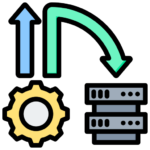Introduction to Role of FPGAs in High-Performance Computing
Role of FPGA: High-Performance Computing (HPC) is a rapidly growing field that involves processing large amounts of data and performing complex calculations at incredibly high speeds.
Traditional computing technologies, such as Central Processing Units (CPUs) and Graphics Processing Units (GPUs), have limitations in terms of performance and flexibility. This is where Field Programmable Gate Arrays (FPGAs) come into play.

FPGAs offer unique advantages in High-Performance Computing, such as low latency, high energy efficiency, and high parallelism, making them a promising technology for developing high-performance computing systems.
In this blog, we will explore the role of FPGAs in High-Performance Computing, their advantages, use cases, and HPC applications.
Definition of FPGAs & Brief History of FPGAs

A Field Programmable Gate Array (FPGA) is a semiconductor device that can be programmed and reprogrammed after manufacturing to perform a specific set of tasks or functions.
FPGAs consist of configurable logic blocks (CLBs), interconnects, and input/output (I/O) blocks, which can be programmed to create custom digital circuits.
Unlike Application-Specific Integrated Circuits (ASICs), which are designed for a specific function, FPGAs are highly versatile and can be reconfigured for different tasks.
Related Read: FPGA VS ASIC Design [Comparison]
FPGAs were first developed in the 1980s by a company called Xilinx, which is still one of the leading FPGA manufacturers today.
Over the years, FPGAs have undergone significant developments, including improvements in performance, power efficiency, and the introduction of new programming tools and languages.
Today, FPGAs are used in a wide range of applications, including telecommunications, automotive, aerospace, and high-performance computing.
They have become increasingly popular in HPC applications due to their parallel processing capabilities, low latency, and energy efficiency.
FPGA in High-Performance Computing

The role of FPGAs in High-Performance Computing (HPC) is to provide a highly flexible and parallel computing platform that can accelerate complex computations and data processing tasks.
FPGAs are also capable of processing large volumes of data in real-time, making them well-suited for high-performance data processing applications.
FPGAs have several advantages in High-Performance Computing applications, such as parallel processing capabilities, low latency, and high energy efficiency.
They have been used in various High-Performance Computing use cases such as machine learning, cryptography, and data compression.
Compared to other FPGA High-Performance Computing technologies such as GPUs, CPUs, and ASICs, FPGAs have shown promising results in terms of performance and efficiency.
FPGA Advantages in High-Performance Computing

Field Programmable Gate Arrays (FPGAs) have emerged as a promising technology for High-Performance Computing (HPC) applications.
FPGAs offer several advantages over traditional computing technologies, including CPUs and GPUs.
Here are some of the key advantages of using FPGAs in HPC:
Parallelism:
 FPGAs are highly parallel and can perform multiple computations simultaneously. This makes them well-suited for HPC applications that require processing large amounts of data in parallel.
FPGAs are highly parallel and can perform multiple computations simultaneously. This makes them well-suited for HPC applications that require processing large amounts of data in parallel.
FPGAs can be programmed to implement custom hardware circuits that can execute specific algorithms much faster than CPUs and GPUs, making them ideal for applications such as data analytics, machine learning, and scientific simulations.

Low Latency:
FPGAs offer low-latency processing, which is critical for many HPC applications. They can perform computations with minimal delay, making them well-suited for real-time applications such as financial trading, network packet processing, and image processing.
 Energy Efficiency:
Energy Efficiency:
FPGAs are highly energy-efficient compared to CPUs and GPUs. They consume less power and generate less heat, which makes them ideal for HPC applications that require high computing power while keeping energy consumption and heat generation to a minimum.
 Flexibility:
Flexibility:
FPGAs offer a high degree of flexibility compared to CPUs and GPUs. They can be programmed and reprogrammed after manufacturing to perform a specific set of tasks or functions, making them highly adaptable to changing HPC application requirements.
 Customization:
Customization:
FPGAs can be customized to implement specific hardware circuits that can accelerate specific HPC applications. This level of customization is not possible with CPUs and GPUs, which are general-purpose processors.
 High Bandwidth:
High Bandwidth:
FPGAs offer high-bandwidth processing capabilities, which makes them ideal for applications that require processing large amounts of data in real-time. They can be programmed to interface directly with high-speed memory and I/O devices, enabling high-throughput data processing.
FPGAs offer several advantages over traditional computing technologies, making them an attractive option for HPC applications that require high performance, low latency, and energy efficiency.
FPGAs can be used to accelerate a wide range of HPC applications, from data analytics and machine learning to scientific simulations and real-time data processing.
FPGA use cases in High-Performance Computing

Field Programmable Gate Arrays (FPGAs) are being increasingly used in High-Performance Computing (HPC) applications to provide high computing power, low latency, and energy efficiency.
Here are some of the key use cases for FPGAs in HPC:
 Data Analytics:
Data Analytics:
FPGAs can be used to accelerate data analytics applications, including data mining, data warehousing, and data visualization.
FPGAs can process large volumes of data in parallel, enabling faster analysis and decision-making.
Machine Learning:
FPGAs can be used to accelerate machine learning applications, including deep learning, reinforcement learning, and neural networks.
FPGAs can be programmed to implement custom hardware circuits that can accelerate specific machine-learning algorithms, making them ideal for real-time applications that require low-latency processing.
 Scientific Simulations:
Scientific Simulations:
FPGAs can be used to accelerate scientific simulations, including molecular dynamics simulations, quantum simulations, and fluid dynamics simulations.
FPGAs can perform parallel computations much faster than CPUs and GPUs, enabling faster simulations and more accurate results.
 Financial Trading:
Financial Trading:
FPGAs can be used to accelerate financial trading applications, including high-frequency trading and algorithmic trading.
FPGAs can perform computations with minimal delay, enabling traders to execute trades much faster than with traditional computing technologies.
 Network Packet Processing:
Network Packet Processing:
FPGAs can be used to accelerate network packet processing applications, including packet filtering, packet classification, and packet forwarding.
FPGAs can process network packets in real-time, enabling faster and more efficient network operations.
 Image Processing:
Image Processing:
FPGAs can be used to accelerate image processing applications, including image recognition, object detection, and video analytics. FPGAs can perform image processing tasks in real-time, enabling faster and more accurate results.
FPGAs are being increasingly used in a wide range of HPC applications to provide high computing power, low latency, and energy efficiency.
FPGAs can be programmed to implement custom hardware circuits that can accelerate specific algorithms and applications, making them well-suited for real-time applications that require fast and efficient processing.
Challenges and Limitations
Challenges:

- Programming Difficulty:
- Code for FPGAs: To program FPGAs, people often use languages like Verilog or VHDL. These are called Hardware Description Languages.
- Hard to Learn: Understanding how to create designs for FPGAs isn’t easy. It requires special skills, and learning about FPGA programming can be tough.
- Development Time:
- Long Build Time: Crafting and refining FPGA projects often take longer than usual CPUs or GPUs work.
- Resource Constraints:
- Sparse Supplies: FPGAs have only so many logic elements, memory, and digital signal processors. Allocating these efficiently can be tricky, and making sure designs are lean on resource use is key.
- Tooling and Ecosystem;
- Availability of Tools: The tools used for developing FPGA may not be as advanced or widely available compared to those used for CPUs or GPUs.
- Ecosystem support: In comparison, to high-performance computing architectures the support system encompassing FPGAs (including frameworks and libraries) might not be as extensive.
- Algorithm Mapping:
- Algorithm Mapping: For certain algorithms, FPGA acceleration is not suitable. Finding and mapping algorithms to leverage FPGA advantages can be challenging.
Limitations:

- Power Consumption:
- Power Efficiency: Even though FPGA consumes very small power for certain workloads, they cannot always perform per watt than CPUs or GPUs, specifically when it comes to low-parallel workloads
- Specialized Workloads:
- Workload Specificity: FPGAs will not always offer a universal speedup across a range of applications, but they are effective for certain tasks. They also perform well in situations where hardware acceleration and parallelism are important.
- Memory Hierarchy:
- Memory Access: Certain memory-bound workloads may be impacted by the memory hierarchy on FPGAs being less adaptable or optimized than on traditional processors.
- Vendor Lock-In:
- Vendor Dependence: There may be vendor lock-in problems because different FPGA vendors have proprietary tools and architectures.
- Scalability:
- Scalability Challenges: FPGA-based solutions can be difficult to scale, particularly when it comes to communication and interconnectivity amongst several FPGAs.
Future of FPGAs in High-Performance Computing
Potential Applications of FPGAs in Future High-Performance Computing Systems

Field-programmable gate arrays (FPGAs) have the potential to revolutionize
High-Performance Computing (HPC) systems in the future. Here are some potential applications of FPGAs in future HPC systems:
 Artificial Intelligence and Machine Learning:
Artificial Intelligence and Machine Learning:
One of the most promising applications of FPGAs is in the field of artificial intelligence (AI) and machine learning (ML).
FPGAs can be used to accelerate the training and inference of neural networks by implementing custom hardware to perform specific operations.
This can result in significant performance improvements compared to traditional CPU and GPU-based systems.
 Big Data Analytics:
Big Data Analytics:
FPGAs can also be used to accelerate big data analytics applications.
By implementing custom hardware to perform specific operations, FPGAs can significantly reduce the time it takes to process large datasets. This is particularly useful in applications such as financial modeling, scientific simulations, and weather forecasting.
 Network Security:
Network Security:
FPGAs can be used to implement custom hardware-based security solutions.
By implementing security algorithms and protocols in hardware, FPGAs can provide faster and more efficient security solutions compared to traditional software-based solutions.
 Cloud Computing:
Cloud Computing:
FPGAs can also be used in cloud computing environments to provide customized hardware acceleration to specific applications.
This can improve the performance of cloud-based applications while reducing costs by reducing the need for additional hardware resources.
 High-Performance Computing:
High-Performance Computing:
FPGAs can be used to accelerate traditional HPC applications such as numerical simulations, computational fluid dynamics, and molecular dynamics.
By implementing custom hardware to perform specific operations, FPGAs can significantly improve the performance of these applications.
 Internet of Things (IoT):
Internet of Things (IoT):
FPGAs can also be used in IoT devices to implement custom hardware-based solutions for data processing and analysis. This can improve the performance and efficiency of IoT devices while reducing power consumption.
FPGAs have the potential to revolutionize HPC systems in the future by providing customized hardware acceleration to specific applications. These applications include AI and ML, big data analytics, network security, cloud computing, HPC, and IoT devices.
Final thoughts on the future of FPGAs in HPC

Field Programmable Gate Arrays (FPGAs) have come a long way in the last few years and are increasingly being considered for use in High-Performance Computing (HPC) applications.
With their ability to be reprogrammed to perform specific tasks, FPGAs offer a level of flexibility and performance that is hard to match with traditional CPUs and GPUs.
Overall, the future of FPGAs in High-Performance Computing looks promising. As they become more powerful, more energy-efficient, and easier to program, FPGAs are likely to become an increasingly important part of the HPC landscape.
It will be interesting to see how this technology develops in the coming years and what new opportunities it will bring to the field of scientific computing.



 Energy Efficiency:
Energy Efficiency: Flexibility:
Flexibility: Customization:
Customization: High Bandwidth:
High Bandwidth:  Data Analytics:
Data Analytics:
 Scientific Simulations:
Scientific Simulations: Financial Trading:
Financial Trading: Network Packet Processing:
Network Packet Processing: Image Processing:
Image Processing:  Artificial Intelligence and Machine Learning:
Artificial Intelligence and Machine Learning: Big Data Analytics:
Big Data Analytics: Network Security:
Network Security: Cloud Computing:
Cloud Computing: Internet of Things (IoT):
Internet of Things (IoT):






